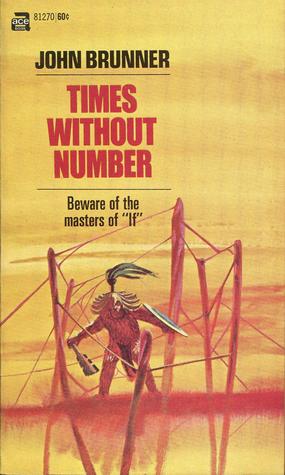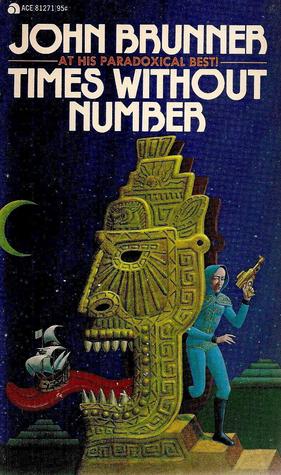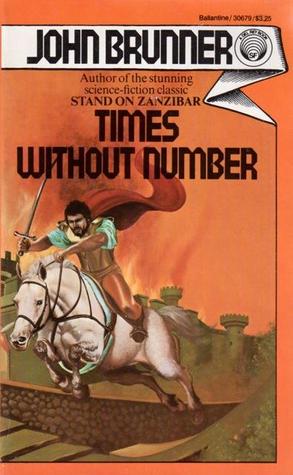Aztec Empires, Amazons, and the Spanish Armada: Rich Horton on John Brunner’s Times Without Number
 |
 |
 |
In addition to his reviews here at Black Gate, Rich Horton has been quietly reviewing neglected SF and fantasy classics on his own blog, Strange at Ecbatan, to great effect for the past few years. We recently highlighted one of his more intriguing choices, the 1961 Ace Double Wandl the Invader/I Speak For Earth.
This month he turns his attention to another neglected John Brunner masterwork, the 1962 fix-up novel Times Without Number, originally published as an Ace Double in 1962 (cover here).
This is one of my favorite time travel/alternate history novels, and it’s a novel that to my mind does not get the notice it deserves… This book is about Don Miguel Navarro of the Society of Time. It is set in an alternate 1988/1989 in which the Spanish Armada succeeded, and established an Empire. The Moors reconquered Spain, but much of Western Europe, including England, remained under Spanish rule, and the independent Mohawk nation in North America was also allied to the Empire. In 1892 the secret of time travel was discovered, and under the auspices of the Pope the Society of Time was established…
The last story, “The Fullness of Time,” is first rate… Don Miguel, on vacation in California, uncovers what seems to be evidence that the Eastern Confederacy, rivals to the Empire, have been mining in California in the distant past. This seems obviously a violation of the prohibition on altering the past, which is enshrined in the Treaty of Prague, but by some literally Jesuitical logic, it seems that possibly no violation has occurred. However, the mining is stopped — but it turns out that something much more sinister is going on. There may be a plot to go back to the time of the Armada and alter history so that England wins. Don Miguel, among a host of others, is sent back to 1588 to try to stop this alteration.
The ending is purely brilliant, to my mind. Brunner faces the implications of time travel directly and honestly, and comes to the only sensible conclusion. And he doesn’t shy away from that conclusion.
Times Without Number was reprinted in a revised and expanded Ace paperback edition in 1969 (above left, cover by John Schoenherr). It was reprinted by Ace again in 1975 (above middle, cover by Don Punchatz), and in 1983 by Del Rey (right, cover by Michael Ferris).
Read Rich’s complete review here.
See all of our recent Vintage Treasures here.
I -am- affected by cover art. The book on the left I might be attracted to. The middle one wouldn’t greatly attract me. The Ballantine on the right would put me off: I’d almost never consider reading a book with a cover like that unless I had seen a very favorable review that I was inclined to trust.
All of which is hardly worth mentioning except that I’m fessing up to something that others might be swayed by, the influence of cover art.
Major,
Indeed. Most of us are very influenced by cover art, whether we admit it or not.
I agree that the John Schoenherr cover is by far the most visually intriguing of the set. But I also admit to a certain fondness for the Punchatz.
As for the Del Rey cover… well, here we have a completely different dynamic at work. Del Rey re-issued about a dozen Brunner paperbacks in the early 80s, all with matching cover designs. Del Rey wasn’t stupid… he knew that if his young readers enjoyed some of them, he could train them to identify a Brunner cover at a glance (even if they never remembered Brunner’s name). This is the era when I discovered Brunner, starting with the brilliant STAND ON ZANZIBAR, in a Del Rey edition, which quickly became one of my favorite books. So I admit to a certain collector’s appeal for the 80s Del Rey editions, even if I agree that the actual artwork isn’t anything special.
Even the typography declines.
Unlike Major, the middle cover is my favorite.
I have a bunch of Brunner in my collection: Stand on Zanzibar of course, but also the sadly prescient The Sheep Look Up (which also has one of my favorite titles of *any* book; as you might imagine, Do Androids Dream of Electric Sheep is also on that list 😉 ), and many others.
But I don’t think I’d heard of this one previously (although there’s always the chance I’ll be sorting books in the future and discover I already have it!). While I appreciate an interesting cover, I’m not a cover buyer per se, so I just spent the relatively cheap $6.99 to buy the Kindle version.
De gustibus! It’s the standalone Ace edition in the middle that is on my shelf, and that appeals to me most strongly. I like the colors, and that guy sneaking behind the idol with the raygun in his hand.
> I have a bunch of Brunner in my collection: Stand on Zanzibar of course, but also the sadly prescient The Sheep Look Up
Allen,
I’m very embarrassed to admit that I have not read THE SHEEP LOOK UP, although I understand it is one of Brunner’s most highly-regarded novels.
> there’s always the chance I’ll be sorting books in the future and discover I already have it!
You have NO IDEA how often that happens to me…
> It’s the standalone Ace edition in the middle that is on my shelf, and that appeals to me most strongly. I like the
> colors, and that guy sneaking behind the idol with the raygun in his hand.
James,
I know! Any cover with a raygun instantly gets extra points. Plus a Spanish galleon and a giant Aztec head? That cover succeeds on so many levels.